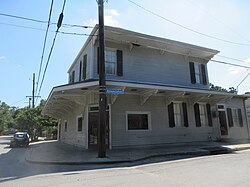| Clancy's | |
|---|---|
 | |
 | |
| Restaurant information | |
| Established | Late 1940s |
| Owner | Brad Holingsworth |
| Food type | Louisiana Creole cuisine |
| Location | 6100 Annunciation Street, Uptown New Orleans, Louisiana, United States |
| Reservations | Accepted |
| Website | Clancyneworleans.com |
Clancy's is a restaurant in New Orleans situated on 6100 Annunciation Street in the Uptown New Orleans district of New Orleans, Louisiana, near Audubon Park. It, like many of its New Orleans coevals, specializes in Louisiana Creole cuisine. Signature dishes include lemon ice box pie, fried oysters with brie (described in New Orleans Cuisine: Fourteen Signature Dishes and Their Histories as "irresistible"), smoked soft-shell crab, [1] and smoked duck. [2] Their oysters Rockefeller and Oysters Bedouin are also remarked upon. [2]